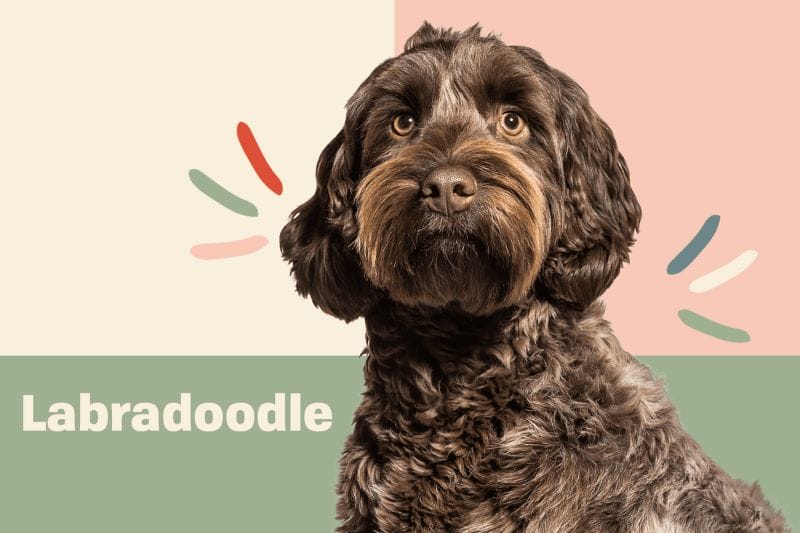The Labradoodle, a crossbreed with an intriguing blend of Labrador Retriever and Poodle genetics, has won over the hearts of dog enthusiasts around the world. In this comprehensive guide, we will embark on a journey to discover the origins, characteristics, care, and common inquiries surrounding the beloved Labradoodle breed.

Exploring the Labradoodle Dog Breeds: A Comprehensive Guide to a Unique Canine Companion
Labradoodle Dog Breed Overview:
Adaptability ★★★★☆
All-around Friendliness ★★★★★
Affectionate With Family ★★★★★
Kid-Friendly ★★★★★
Dog Friendly ★★★★☆
Friendly Toward Strangers ★★★★☆
Health And Grooming Needs ★★★☆☆
Amount Of Shedding ★★★★☆
Drooling Potential ★☆☆☆☆
Easy To Groom ★★★☆☆
General Health ★★★☆☆
Potential For Weight Gain ★★★☆☆
Size ★★★★☆
Trainability ★★★★★
Easy To Train ★★★★★
Intelligence ★★★★★
Potential For Mouthiness ★☆☆☆☆
Prey Drive ★★★☆☆
Tendency To Bark Or Howl ★★★☆☆
Wanderlust Potential ★★★☆☆
Exercise Needs ★★★★☆
Energy Level ★★★★☆
Intensity ★★★☆☆
Exercise Needs ★★★★☆
Potential For Playfulness ★★★★★
Origins and General Information
The Labradoodle’s story begins in the 1980s, when Wally Conron, an Australian breeder, aimed to create a hypoallergenic guide dog for visually impaired individuals. The result of his efforts was a cross between a Labrador Retriever and a Poodle. They appeal quickly grew, and they soon found their place not only as guide dogs but also as beloved companions and therapy dogs.
Labradoodles at a Glance
- Mixed or Original Breed: They is a crossbreed, a fusion of the Labrador Retriever and Poodle breeds.
- Appearance: They exhibit a diverse range of physical traits, reflecting their mixed heritage. They come in various sizes, coat textures, and colors.
- Characteristics: Their coat can be curly, wavy, or straight, and it’s often low-shedding, making them appealing to those with allergies.
- Popularity: They have become increasingly popular due to their hypoallergenic qualities, friendly disposition, and versatility as family pets and service dogs.
- Lifespan: On average, They typically have a lifespan of around 10 to 15 years. However, some individuals might live longer, while others might have shorter lifespans due to various factors.
- Coat Color: They come in a wide variety of coat colors and patterns, making them even more unique and appealing to dog enthusiasts. The coat color can vary based on their genetic heritage, as well as the specific combination of Labrador Retriever and Poodle genes they inherit. Here are some common coat colors and patterns found:
- Solid Colors:
Cream: A light, creamy color that ranges from almost white to a slightly deeper shade.
Apricot: A warm, orange-gold color that resembles the fruit’s hue.
Red: A deep, rich red color that can vary in intensity.
- Parti-Colors:
Black and White: A combination of black and white patches or markings on the coat.
Chocolate and White: A blend of chocolate (brown) and white markings.
Apricot and White: A mix of apricot and white patches.- Merle Patterns:
Blue Merle: A marbled pattern of blue-gray and black, often with specks of white.
Red Merle: A marbled pattern of red and tan, with variations in intensity.- Phantom and Sable:
Phantom: This pattern consists of two colors, with one color (usually lighter) appearing as markings on specific areas like the eyebrows, legs, and under the tail.
Sable: Sable they have a coat with a mixture of colors, often including black-tipped hairs on a lighter base.- Parti-Phantom:
Parti-Phantom: A combination of the parti-color and phantom patterns, resulting in a coat with multiple colors and distinct markings.- Abstract and Tuxedo:
Abstract: Patches of color are dispersed across the coat, creating a unique and irregular pattern.
Tuxedo: A coat with a solid color body and distinct white markings on the chest, paws, and sometimes the face, resembling a tuxedo suit.
How to Take Care of a Labradoodle
Food:
Feeding your pet a well-balanced diet is essential for their health and well-being:
- Protein: Opt for high-quality sources of protein to support muscle growth and overall vitality.
- Healthy Fats: Incorporate Omega-3 fatty acids for skin health and a lustrous coat.
- Whole Grains: Complex carbohydrates provide sustained energy levels.
Environment:
Creating a suitable environment is key to your Labradoodle’s happiness and well-being:
- Indoor Living: They thrive indoors as valued family members. Provide a comfortable space for them to relax.
- Regular Exercise: Regular walks and play sessions keep they physically and mentally stimulated.
- Safety Measures: Ensure your home is free from hazards and toxic substances to keep your dog safe.

Take Care Method:
To ensure a content and vibrant, prioritize regular exercise, mental stimulation, and affection:
- Exercise: Regular walks, playtime, and activities such as fetch help them burn energy.
- Mental Stimulation: Engage their minds through interactive toys and puzzle games.
- Socialization: Introduce your pet to various people, animals, and environments to foster positive behavior.
Grooming:
Maintaining your Labradoodle’s coat is essential to their well-being. Here’s a recommended grooming routine:
- Brushing: Brush your Labradoodle’s coat 2-3 times a week to prevent matting and tangles. Use a slicker brush or a pin brush, depending on their coat type.
- Bathing: Bathe your Labradoodle every 4-6 weeks or as needed. Use a gentle dog shampoo to avoid skin irritation.
- Face Clean-Up: Clean the area around their eyes and ears regularly to prevent tear stains and wax buildup.
- Nail Check: Trim your Labradoodle’s nails every 2-4 weeks to prevent overgrowth and discomfort.
Regular grooming not only keeps your Labradoodle looking its best but also helps maintain their comfort and overall health.
How to Buy or Adopt a Labradoodle
Locations of Popularity:
They have gained popularity globally, with a notable presence in both urban and suburban settings.
Average Price:
The cost of varies based on factors such as size, coat type, and breeder reputation, typically ranging from $1,000 to $3,000.
Community for Labradoodle Adoption:
Online platforms like Facebook and Instagram often host groups dedicated to enthusiasts, providing adoption resources and valuable advice.
What to Check Before Adopting/Buying a Labradoodle:
- General Health: Select that appears healthy, active, and free from visible health concerns.
- Vaccination Status: Ensure their vaccinations are up-to-date to protect against preventable diseases.
- Medical History: Gathering information about past health issues informs their future care.
How to Prepare for a Labradoodle’s Life
- Advice: Approach their care with patience, love, and dedication.
- Care Essentials: Establish a nutritious diet, safe living space, engaging toys, grooming routine, and training regimen.
- Essential Equipment: Equipments such as a comfortable bed, leash, grooming tools, and interactive toys cater to their needs.
- Common Diseases: While generally healthy, they can be susceptible to hip dysplasia, ear infections, and allergies. Regular veterinary visits are vital.
- Necessary Vaccines: Core vaccines include rabies, distemper, and parvovirus.
Common Name for Labradoodles
- Advice: Choose a name that resonates with your pet’s personality and spirit.
- Common Names: Popular names include Daisy, Cooper, Bella, Charlie, and Lucy.

In summary, they unique blend of Labrador Retriever and Poodle genetics has created a breed cherished for its versatile nature and hypoallergenic qualities. By understanding their origins, optimal care, and addressing frequently asked questions, you can provide with a joyful and fulfilling life as a cherished member of your family.
More information about Dog Breeds & Dog Care follow Dog Care Tips site.
How Often Should We Check for Labradoodle’s Health with a Vet?
Regular veterinary check-ups are recommended annually to monitor overall health and address potential concerns promptly.
Are Labradoodles Good Family Pets?
Yes, It’s friendly nature and adaptability make them excellent family companions.
Are Labradoodle Dogs Good with Children?
Proper socialization and supervision ensure harmonious interactions between they and children.
Are Labradoodle Dogs Good with Other Animals?
Early socialization and controlled introductions enable they to get along well with other pets.
How Many Types of Labradoodle Are There?
They can vary in size, coat type, and color, but there is no formal classification of distinct types.
Is a Labradoodle a Smart Dog?
Yes, they exhibit high intelligence and are quick learners.
Can Labradoodles Cause Allergies?
Their hypoallergenic coat may be suitable for some individuals with allergies, but reactions can vary.
Are Labradoodles Ferocious?
With proper training and socialization, Labradoodles are not typically ferocious.
Do Labradoodles Experience Hair Loss Problems?
They are generally low-shedding, but regular grooming is necessary to maintain coat health and appearance.
How to Stop Labradoodle Biting?
Early socialization and consistent training are essential to curb biting behavior. Use positive reinforcement to reward desired behavior.
How to Socialize and Raise Friendliness in Labradoodles?
Expose your pet to various people, animals, and environments from a young age to foster sociability.
How to Train Your Labradoodle?
Utilize positive reinforcement methods and consistency to teach commands, encourage good behavior, and deepen your bond.

